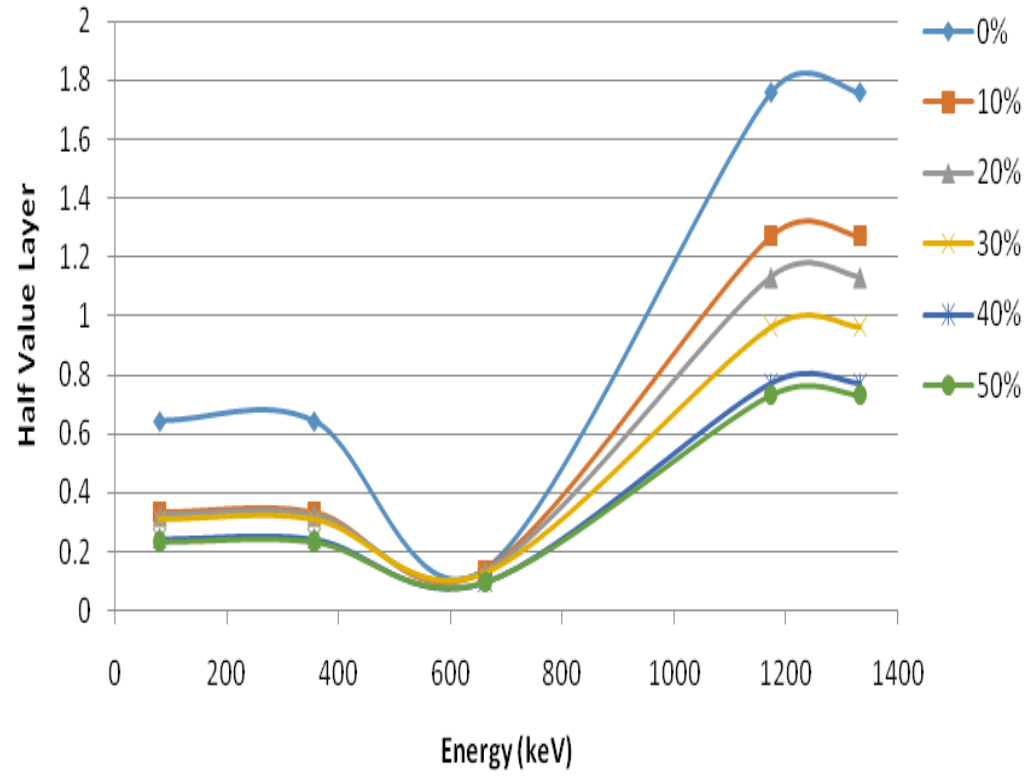Assessment of Radiation Shielding Properties of Polymer-Lead (II) Oxide Composites
Keywords:
PbO, PANI, HVL, Epoxy, attenuationAbstract
Long term exposure to very high levels of radiations from medical diagnostic centres, industries, nuclear research establishments and nuclear weapon development have resulted in health effects such as cancer and acute radiation syndrome, hence the need for proper radiation shielding. This paper investigated Epoxy-Lead (II) Oxide (PbO) composite as radiation shielding. The composites were prepared by dispersion of microsized PbO particles into polymeric materials using effective melt-mixing method and cast in a 4 cm by 6 cm rectangular aluminium Mold with a thickness of 5 mm and was allowed to set over night at room temperature. The gamma ray attenuation ability of the composites were studied using gamma ray transmission or attenuation coefficient determination for the gamma ray energy. Three gamma ray sources Ba-133, Cs-137 and Co-60 were employed. The density, linear attenuation coefficient, half value layer (HVL), relaxation length and heaviness of the samples were determined. The measured values of linear attenuation coefficient increased with increasing filler concentration in all the samples at all gamma ray energies. It was also noticed that 40 % and 50 % filler samples attenuates more relative to the other samples under study. The maximum linear attenuation attained was found at energy of 662 keV. The composites have been found to possessed medical gamma-ray attenuation characteristics among the sample materials over a certain photon energy range (0.08 MeV–1.332 MeV) and found useful as a biological radiation shielding against gamma rays.

Published
How to Cite
Issue
Section
Copyright (c) 2021 Journal of the Nigerian Society of Physical Sciences

This work is licensed under a Creative Commons Attribution 4.0 International License.
How to Cite
Similar Articles
- U. Rilwan, M. I. Sayyed, K. A. Mahmoud, S. Muhammad, A. Alkasim, S. I. Ikpughul, S. J. Iwa, Jibrin Ahmed Guto, O. A. Adeyeba, M. W. Marashdeh, Evaluation of radiation shielding and mechanical properties of palm nut shell ash modernized concrete: a comparative analysis , Journal of the Nigerian Society of Physical Sciences: Volume 8, Issue 1, February 2026 (In Progress)
- Elsammani Ali Shokralla, Improving the thermal stability and dielectric properties of epoxy/phenolic resin type (novolac) composites by incorporating carbon nanofibers (CNFs) , Journal of the Nigerian Society of Physical Sciences: Volume 7, Issue 1, February 2025
- A. M. Olaosun, C. A. Aborisade, D. E. Shian, P. T. Osuolale, Comprehensive study of photon and proton interactions to interpret the radiation parameters of boron derivative drugs for chemoradiotherapy , Journal of the Nigerian Society of Physical Sciences: Volume 7, Issue 2, May 2025
- Edikan E. Akpanibah, Udeme Ini, Portfolio Strategy for an Investor with Logarithm Utility and Stochastic Interest Rate under Constant Elasticity of Variance Model , Journal of the Nigerian Society of Physical Sciences: Volume 2, Issue 3, August 2020
- Edikan E. Akpanibah, Udeme O. Ini, An Investor’s Investment Plan with Stochastic Interest Rate under the CEV Model and the Ornstein-Uhlenbeck Process , Journal of the Nigerian Society of Physical Sciences: Volume 3, Issue 3, August 2021
- Uthumporn Panitanarak, Aliyu Ismail Ishaq, Alfred Adewole Abiodun, Hanita Daud, Ahmad Abubakar Suleiman, A new Maxwell-Log logistic distribution and its applications for mortality rate data , Journal of the Nigerian Society of Physical Sciences: Volume 7, Issue 2, May 2025
You may also start an advanced similarity search for this article.







